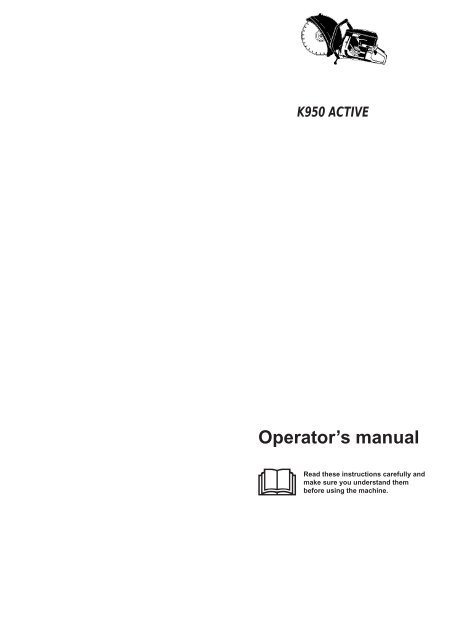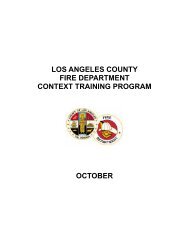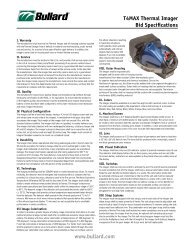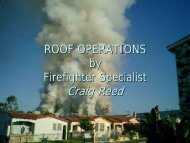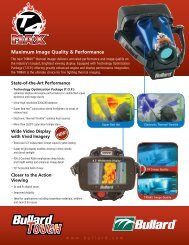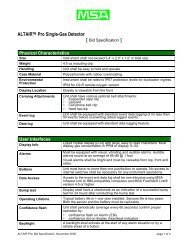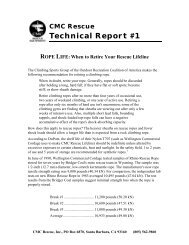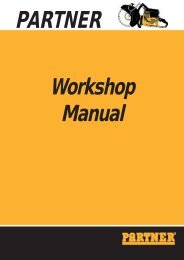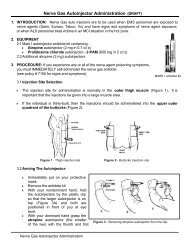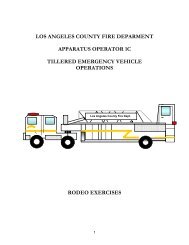PARTNER K950 Operators Manual 1998.pdf
PARTNER K950 Operators Manual 1998.pdf
PARTNER K950 Operators Manual 1998.pdf
You also want an ePaper? Increase the reach of your titles
YUMPU automatically turns print PDFs into web optimized ePapers that Google loves.
<strong>K950</strong> ACTIVE<br />
Operator’s manual<br />
Read these instructions carefully and<br />
make sure you understand them<br />
before using the machine.
Symbols on the power cutter:<br />
SYMBOL EXPLANATION<br />
Symbols in the Operator's <strong>Manual</strong>:<br />
WARNING! The power cutter can be<br />
dangerous! Careless and incorrect use can<br />
result in serious or fatal injury to the<br />
operator or others.<br />
Switch off the engine by moving the stop<br />
switch to the STOP position before carrying<br />
out any checks or maintenance.<br />
Please read the instructions carefully and<br />
make sure you understand them before<br />
using the power cutter.<br />
Always wear approved protective gloves.<br />
Always wear:<br />
• Approved protective helmet<br />
• Approved hearing protection<br />
• Protective glasses or visor<br />
Regular cleaning is required.<br />
Warning<br />
Cutting creates a lots of dust which can<br />
cause inhalation damages. Use appropriate<br />
dust mask or respirator protection. Avoid<br />
breathing petrol fumes and exhaust gases.<br />
Provide for good ventilation.<br />
Visual check.<br />
Warning<br />
Sparks from the cutting blade can cause<br />
fire in combustible materials such as: petrol<br />
(gas), wood, dry grass etc.<br />
Protective glasses or a visor must be worn.<br />
2 – English
Before using your new Power cutter<br />
• Read the Operator’s <strong>Manual</strong> carefully.<br />
• Check the assembly and adjustment of the cutting blade, see<br />
chapter ”Assembly”.<br />
• Start the engine and check the carburettor settings. See<br />
chapter ”Maintenance”, section ”Carburettor”. When adjusted<br />
correctly the cutting blade should not rotate when idling.<br />
Setting the idling speed is described in the Operator’s<br />
<strong>Manual</strong>. Adjust the speed according to these instructions. Do<br />
not use the power cutter if the idling speed is not correctly<br />
adjusted!<br />
• Let your Partner dealer check the power cutter and carry out<br />
essential adjustments and repairs.<br />
!<br />
!<br />
WARNING!<br />
Under no circumstances should you modify<br />
the original design of the power cutter without<br />
approval from the manufacturer. Always use<br />
genuine spare parts. Unauthorized<br />
modifications or accessories may lead to<br />
serious injury or death.<br />
WARNING!<br />
Use of products which cut, grind, drill, sand or<br />
shape material can generate dust and vapors<br />
which may contain harmful chemicals. Know<br />
the nature of the material being worked on<br />
and wear appropriate dust mask or respirator<br />
protection.<br />
CONTENTS<br />
List of Contents<br />
Symbol explanation ..................................................... 2<br />
Safety instructions<br />
Personal protective equipment ....................................... 4<br />
The power cutter’s safety equipment ...................... 4<br />
Control, maintenance and service of the machine‘s safety<br />
equipment ............................................................................ 4<br />
General safety instructions .............................................. 6<br />
Transport and storage ......................................................... 6<br />
Fuel safety ........................................................................... 7<br />
General working instructions ........................................... 7<br />
Cutting ................................................................................. 7<br />
Kickback .............................................................................. 8<br />
Care and storage ................................................................. 9<br />
Cutting blades .................................................................... 10<br />
General .............................................................................. 10<br />
Abrasive blades ................................................................. 10<br />
Diamond blades ................................................................ 11<br />
What is what?<br />
What is what on a power cutter? ....................................... 12<br />
Assembly<br />
Fitting the cutting head ...................................................... 13<br />
Checking the drive shaft and flanges ................................ 13<br />
Fitting the cutting blade ..................................................... 13<br />
Fuel handling<br />
Fuel mixture ....................................................................... 14<br />
Fuelling .............................................................................. 14<br />
Start and stop<br />
Start and stop .................................................................... 15<br />
Maintenance<br />
Adjusting the drive belt ...................................................... 16<br />
Changing the drive belt ..................................................... 16<br />
Carburettor ........................................................................ 17<br />
Fuel filter ............................................................................ 18<br />
Air filter .............................................................................. 18<br />
Starter ................................................................................ 19<br />
Spark plug ......................................................................... 20<br />
Muffler................................................................................ 20<br />
Cooling system .................................................................. 20<br />
Daily maintenance ............................................................. 21<br />
Weekly maintenance ......................................................... 21<br />
Monthly maintenance ........................................................ 21<br />
Technical Data<br />
<strong>K950</strong> Active ....................................................................... 22<br />
English – 3
!<br />
!<br />
WARNING! Incorrect or careless use of a<br />
power cutter can turn it into a dangerous tool<br />
that can cause serious or even fatal injury. It<br />
is extremely important that you read and<br />
understand this manual.<br />
PERSONAL PROTECTIVE EQUIPMENT<br />
WARNING! When using a power cutter,<br />
protective equipment approved by the<br />
appropriate authorities must be used. Personal<br />
protective equipment does not eliminate<br />
the risk of accidents, however, it can reduce<br />
the effects of an injury in the event of an<br />
accident. Ask your dealer for help when<br />
choosing protective equipment.<br />
• PROTECTIVE HELMET<br />
• EAR PROTECTION<br />
• PROTECTIVE GLASSES<br />
OR FULL FACE<br />
PROTECTION<br />
• BREATHING MASK<br />
SAFETY INSTRUCTIONS<br />
THE POWER CUTTER’S SAFETY<br />
EQUIPMENT<br />
This section describes the power cutter’s safety equipment, its<br />
function and how checks and maintenance are carried out to<br />
ensure that it operates correctly. (See the chapter “What is<br />
what“ to locate where this equipment is positioned on your<br />
power cutter.)<br />
!<br />
1 Anti-vibration<br />
system<br />
WARNING! Never use a power cutter with<br />
defective safety equipment. Follow the<br />
control, maintenance and service instructions<br />
described in this manual.<br />
Your power cutter is equipped<br />
with an anti-vibration system.<br />
This is designed to give as low<br />
vibration levels and<br />
comfortable usage as possible.<br />
• HEAVY-DUTY, FIRM GRIP<br />
PROTECTIVE GLOVES<br />
• SNUG-FITTING, HEAVY-<br />
DUTY, COMFORTABLE<br />
CLOTHING THAT ALLOWS<br />
FULL FREEDOM OF<br />
MOVEMENT<br />
The power cutter’s antivibration<br />
system reduces the<br />
transfer of vibration between<br />
the engine/cutting equipment<br />
and the operator. The engine<br />
body including the cutting<br />
equipment is suspended in a<br />
handle system via antivibration<br />
elements.<br />
• LEG PROTECTION (TO<br />
PROTECT AGAINST<br />
SPARKS AND CUTTING<br />
FRAGMENTS)<br />
• ANTI-SLIP BOOTS WITH<br />
STEEL TOE CAPS<br />
2 Stop switch<br />
The stop switch should be<br />
used to stop the engine.<br />
• FIRST AID KIT SHOULD<br />
ALWAYS BE ON HAND<br />
4 – English
SAFETY INSTRUCTIONS<br />
3 Muffler<br />
!<br />
WARNING!<br />
During use and for some time<br />
after the muffler is very hot. Do not touch the<br />
muffler if it is hot!<br />
The muffler is designed to<br />
give the lowest possible noise<br />
level and to direct the engine‘s<br />
exhaust fumes away from the<br />
user. The engine‘s exhaust<br />
fumes are hot and can contain<br />
sparks, which can lead to the<br />
outbreak of fire.<br />
Control, maintenance and service of<br />
the machine‘s safety equipment<br />
!<br />
WARNING! All service and repairs to the<br />
power cutter require special training. This<br />
applies especially to the power cutter’s safety<br />
equipment. If the power cutter does not meet<br />
any of the controls listed below you should<br />
contact your service workshop.<br />
The purchase of one of our products<br />
guarantees that professional repair and<br />
servicing will be carried out on it. If the point<br />
of purchase is not one of our servicing<br />
dealers, please ask for details of the closest<br />
service workshop.<br />
1 Anti-vibration system<br />
Check the anti-vibration<br />
elements regularly for material<br />
cracks and deformation.<br />
IMPORTANT INFORMATION! It is extremely important that<br />
the instructions for checking, maintaining and servicing<br />
the muffler are followed. (see the section “Control,<br />
maintenance and service of the power cutter’s safety<br />
equipment“).<br />
4 Blade guard for the cutting blade<br />
!<br />
WARNING! Always check that the blade guard<br />
is correctly fitted before starting the machine.<br />
The blade guard is mounted<br />
above the cutting blade and<br />
prevents cutting fragments<br />
from being thrown towards the<br />
user.<br />
Check that the anti-vibration<br />
elements are securely<br />
mounted between the engine<br />
unit and the handle system.<br />
2 Stop switch<br />
Start the engine and make<br />
sure that the engine stops<br />
when the stop switch is<br />
moved to the stop position.<br />
English – 5
3 Muffler<br />
Never use a machine that<br />
has a defective muffler.<br />
Check regularly that the<br />
muffler is secured to the<br />
engine body.<br />
SAFETY INSTRUCTIONS<br />
GENERAL SAFETY INSTRUCTIONS<br />
IMPORTANT INFORMATION!<br />
Do not use the power cutter until you have read the<br />
entire contents of this Operator’s <strong>Manual</strong>.<br />
All servicing, in addition to the points listed in the<br />
section ”Control, maintenance and service of the<br />
power cutter’s safety equipment”, should be carried<br />
out by trained service specialists.<br />
• Use the equipment recommended in the chapter ”Personal<br />
safety equipment”.<br />
• Never use the machine when you are tired, under the<br />
influence of medicines/drugs or alcohol.<br />
• Do not lend the power cutter to anyone without providing this<br />
Operator’s <strong>Manual</strong>. Ensure the person using the power cutter<br />
understands the information in this Operator’s <strong>Manual</strong>.<br />
Transport and storage<br />
• Store the power cutter under lock and key so that it’s out of<br />
reach for children and unauthorised persons.<br />
• Do not store or transport the power cutter with the cutting<br />
blade fitted.<br />
4 Blade guard for the cutting blade<br />
Never use a defective blade<br />
guard or a blade guard that is<br />
not fitted correctly.<br />
!<br />
!<br />
WARNING! Check that the cutting blade is<br />
fitted correctly and does not show signs of<br />
damage. A damaged cutting blade can cause<br />
personal injury.<br />
WARNING! Never use a power cutter with<br />
defective safety equipment. The power<br />
cutter’s safety equipment should be checked<br />
and maintained as described in this<br />
Operator’s <strong>Manual</strong>. If your power cutter does<br />
not meet any of these controls you should<br />
contact your service workshop.<br />
6 – English
Fuel safety<br />
(Filling/Fuel mixture/Storage)<br />
!<br />
WARNING! Exercise great care when handling<br />
fuel. Bear in mind the risk of fire, explosions<br />
and inhaling fumes.<br />
SAFETY INSTRUCTIONS<br />
GENERAL WORKING INSTRUCTIONS<br />
This section takes up the basic safety precautions for working<br />
with the power cutter. Follow these general working instructions,<br />
but never use a machine without the possibility of calling for<br />
help in the event of an accident.<br />
Basic safety precautions<br />
• Never fill the machine while<br />
the engine is running.<br />
• Provide good ventilation<br />
when filling or mixing fuel<br />
(gasoline and 2-stroke oil).<br />
• Move the machine at least 3<br />
m from the filling position<br />
before starting.<br />
• Never start the machine:<br />
a) If you have spilt fuel<br />
on it. Wipe up all<br />
spillage.<br />
b) If you have spilt fuel<br />
on yourself or your<br />
clothes. Change your<br />
clothes.<br />
c) If there is a fuel leak.<br />
Make regular checks for<br />
leakage from the fuel<br />
cap and the fuel supply<br />
pipes.<br />
• Store the power cutter and fuel so that any leakage or fumes<br />
do not risk coming into contact with sparks or naked flames.<br />
For example, electric machines, electric motors, electrical<br />
switches/power switches, heaters or the like.<br />
• When storing fuel, approved containers intended for this<br />
purpose must be used.<br />
• When storing the power cutter for long periods the fuel tank<br />
must be emptied. Contact your local fuel station to find out<br />
how to dispose of excess fuel.<br />
• Use a Partner fuel can with an anti-spill device.<br />
Min 3 m<br />
(10ft)<br />
IMPORTANT INFORMATION! Never work with a power<br />
cutter that is defective or incorrectly adjusted. Do not<br />
work with a power cutter that is incomplete or where<br />
assembly has not been carried out in a satisfactory<br />
manner. Check that the cutting blade stops rotating<br />
when the throttle is released. If you encounter a situation<br />
where you are uncertain how to proceed you should ask<br />
an expert.<br />
Avoid all usage which you consider to be beyond your<br />
capability.<br />
• Check that no one is in the immediate vicinity when the<br />
machine is started or while working with the machine to<br />
ensure that people, animals or other things cannot affect your<br />
control of the power cutter.<br />
• Avoid usage in unfavourable weather conditions, for example,<br />
thick fog, heavy rain, strong winds or extreme cold, etc. To<br />
work in bad weather conditions is tiring and can create<br />
dangerous circumstances, e.g. slippery surfaces.<br />
• Never start to work with the power cutter before the working<br />
area is clear and you have a firm foothold. Look out for any<br />
obstacles with unexpected movement. Ensure when cutting<br />
that no material can become loose and fall, causing operating<br />
injury.Take great care when working on sloping ground.<br />
• Make sure clothing and parts of the body do not come into<br />
contact with the cutting blade when the engine is started.<br />
• Maintain a safe distance from the cutting blade when the<br />
engine is running.<br />
• The blade guard should always be fitted when the engine is<br />
running.<br />
• Ensure that the working area is sufficiently illuminated to<br />
create a safe working environment.<br />
• Some working positions may create greater stress on the<br />
operator.<br />
• Check the cutting area for buried cables and wires.<br />
!<br />
WARNING! Use a Partner fuel can with an<br />
anti-spill device. Fuel and fuel fumes are<br />
highly flammable. Think of the risks of fire,<br />
explosion and breathing in fumes. Stop the<br />
engine before refuelling. Do not overfill with<br />
fuel. Mop up any spills on the ground or the<br />
machine. If you spill fuel on yourself or your<br />
clothes, change your clothes. Move the<br />
machine at least 3 metres from the refuelling<br />
site before starting.<br />
!<br />
Only use the machine in areas with good<br />
ventilation. Neglect can result in serious<br />
injury or death.<br />
Cutting<br />
!<br />
WARNING! A safe distance from the power<br />
cutter is 15 metres. You are responsible that<br />
animals and onlookers are not in the working<br />
area. Do not start to work with the power<br />
cutter before the working area is clear and<br />
you have a firm foothold.<br />
• Start cutting with the engine at full throttle.<br />
• Always hold the power cutter firmly, with both hands. Hold<br />
the machine so that the thumb and fingers grip around the<br />
handle.<br />
English – 7
!<br />
Over<br />
exposure to vibrations can result in<br />
blood-vessel or nerve injury to persons<br />
suffering with blood circulation problems.<br />
Seek medical attention if you experience<br />
physical symptoms that can be related to over<br />
exposure to vibrations. Examples of such<br />
symptoms are numbness, lack of feeling,<br />
“tickling“, “pricking“, pain lack of or a<br />
reduction in normal strength, changes in the<br />
colour of the skin or its surfaces. These<br />
symptoms normally appear in the fingers,<br />
hands or wrists.<br />
SAFETY INSTRUCTIONS<br />
Water cooling<br />
!<br />
WARNING! Water cooling, which is only used<br />
for petrol-driven power cutters and when<br />
cutting concrete, cools the cutting blade and<br />
increases its service life as well as reduce<br />
dust formation (see the section ”Abrasive<br />
blades”). Among the disadvantages are<br />
difficulties at very low temperatures, the risk<br />
of damaging the floor and other sections of<br />
the building and risk for slippage.<br />
Cutting technique<br />
The technique described below is of a general character. Check<br />
information for each blade regarding individual cutting characteristics.<br />
(For example, a diamond blade requires less feeding<br />
pressure than a abrasive blade).<br />
1.Support the work piece<br />
in such away that you<br />
can predict what will<br />
happen and so it will not<br />
pinch.<br />
2.Always cut at full throttle.<br />
3.Start cutting gently, do<br />
not force or squeeze the<br />
blade in.<br />
4.Use a high blade speed.<br />
5.Move the blade slowly<br />
backwards and forwards.<br />
6.Use a small part of the<br />
blade’s cutting edge.<br />
7.Only use the blade’s<br />
cutting edge when<br />
cutting.<br />
8.Cut with the blade fully<br />
vertical – at right angles<br />
to the work piece.<br />
Sharpening diamond blades<br />
Blades can become dull when the wrong feeding pressure is<br />
used or when cutting some materials such as heavily reinforced<br />
concrete. To force a dull blade results in overheating and finally<br />
the loss of segments (part of the blade).<br />
Sharpen against a soft material such as sandstone, silica or<br />
haydite brick.<br />
Blade vibration<br />
The blade can become out of shape (not round) and vibrate if a<br />
too high feeding pressure is used or if the blade is pressed into<br />
the work piece.<br />
A lower feeding pressure ought to stop the vibration. Otherwise<br />
replace the cutting blade.<br />
Kickback<br />
Kickback can occur very suddenly and with great force. If the<br />
following directives are not followed, it can result in serious or<br />
even fatal injury.<br />
If the sector of the blade illustrated below is used for cutting the<br />
blade can start to climbing and kickback the power cutter<br />
upwards and backwards towards the user with immense force.<br />
How to avoid kickback<br />
1.Never cut with the<br />
segment illustrated in the<br />
diagram.<br />
2.Keep a good balance and<br />
a firm foothold.<br />
!<br />
!<br />
WARNING!<br />
Under all circumstances avoid cutting using<br />
the side of the blade; it will almost certainly<br />
be damaged, break and can cause immense<br />
damage. Only use the cutting section.<br />
WARNING!<br />
Do not lean the blade to the side, this can<br />
cause the blade to jam or break with personal<br />
injury as a consequence.<br />
3.Use both hands and take<br />
a firm grip with the thumb<br />
and fingers around the<br />
handle.<br />
4.Keep the work piece at a<br />
comfortable distance.<br />
5.Use the cutter at full<br />
throttle.<br />
6.Take care when inserting<br />
the blade in an existing<br />
cut.<br />
7.Never cut above shoulder<br />
height.<br />
8.Be alert to movement of<br />
the work piece or anything<br />
else that can occur, which<br />
could cause the cut to<br />
close and pinch the blade.<br />
8 – English
Pull in<br />
Pull in occurs when the lower part of the blade is suddenly<br />
stopped or when the cut closes. (To avoid this see the section<br />
”How to avoid kickback” and ”Pinching/rotation” below).<br />
Pinching/rotation<br />
Pinching occurs when the cut closes. The power cutter can be<br />
drawn suddenly and powerfully downwards.<br />
SAFETY INSTRUCTIONS<br />
Care and storage<br />
General<br />
Partner’s power cutters are robust and durable. However, as<br />
they are used for high speed operations all servicing should be<br />
carried out on time and as specified, so that the power cutter<br />
always works effectively and safely.<br />
How to avoid pinching<br />
Support the work piece in<br />
such a way that the cut<br />
remains open during the<br />
cutting operation and when<br />
the cut is finished.<br />
Drying the blade<br />
After using the blade with<br />
water cooling, let the cutter<br />
run for approx. half a minute<br />
so that the blade dries.<br />
If a damp blade is stored it<br />
can become unbalance and<br />
cause damage.<br />
Check the speed of the<br />
drive shaft<br />
Use a tachometer regularly to<br />
check the speed of the drive<br />
shaft when the cutter is<br />
running at working temperature<br />
and at full throttle without<br />
a load. The maximum speed<br />
is stated on the unit.<br />
Read this Operator’s <strong>Manual</strong> to determine which service<br />
routines you can carry out and ensure that all other service<br />
work is carried out by an authorised service workshop.<br />
Power Cutter<br />
Always handle the power cutter with care and store it with the<br />
blade removed.<br />
Blades<br />
• All blades should be<br />
removed from the cutter<br />
after use and stored<br />
carefully.<br />
• Special care should be<br />
taken with abrasive<br />
blades.<br />
• Blades must be stored on<br />
a firm, level surface. If<br />
blades are supplied with a<br />
backing pad then a spacer<br />
should be used to keep<br />
them flat.<br />
• Avoid moisture and<br />
temperature extremes.<br />
• Remove the blades before<br />
the cutter is moved or<br />
transported.<br />
• Inspect new blades for<br />
transport or storage<br />
damage.<br />
!<br />
WARNING!<br />
If the speed is higher than that stated then the<br />
unit must be adjusted by an authorised<br />
service workshop before it is used.<br />
English – 9
CUTTING BLADES<br />
SAFETY INSTRUCTIONS<br />
Abrasive blades<br />
The cutting material in an abrasive blade consists of abrasive<br />
corn that is held together by an organic bonding agent.<br />
”Reinforced blades” are made up of a fabric or fibre base that<br />
prevents total breakage at maximum working speed if the blade<br />
should be cracked or damaged. (The term reinforced does not<br />
refer to those cutting blades that are only reinforced around the<br />
flange).<br />
A cutting blade’s performance is determined by the type and<br />
size of abrasive corn, and the type and hardness of the bonding<br />
agent.<br />
Characteristics that give the blade a shorter service life and<br />
greater cutting capacity are said to make the blade ”softer”. A<br />
blade with a longer service life and slower cutting capacity is a<br />
blade with a ”harder” effect.<br />
General<br />
Cutting blades are available in two standard designs; abrasive<br />
blades and diamond blades.<br />
High quality cutting blades are normally more economical.<br />
Lower quality cutting blades usually have an inferior cutting<br />
capacity and shorter service life, which results in higher cost per<br />
processed material.<br />
ABRASIVE BLADES, TYPES AND USES<br />
!<br />
WARNING!<br />
A cutting blade may burst and cause injury<br />
to the operator.<br />
Blade<br />
type<br />
General<br />
characteristics<br />
Use<br />
Material<br />
Water cooling<br />
High speed portable tools<br />
Cutting blades of the make Partner are manufactured for<br />
portable, high speed, power cutters. If other makes of cutting<br />
blades are used, ensure the blades comply with all the<br />
directives and requirements attributed to the specific type of<br />
power cutter.<br />
!<br />
WARNING!<br />
Never exceed the maximum working speed of<br />
a cutting blade.<br />
Special blades<br />
Some cutting blades are designed for stationary equipment and<br />
for use with attachments. These types of cutting blades must<br />
not be used on portable, power cutters.<br />
Concrete<br />
Metal<br />
Universal<br />
usage,<br />
economical<br />
Unbeatable for<br />
steel (not<br />
suitable for<br />
concrete, etc.)<br />
Concrete,<br />
asphalt,<br />
stone,<br />
brickwork,<br />
cast iron,<br />
aluminium,<br />
copper,<br />
brass, cables,<br />
rubber, etc.<br />
Steel, steel<br />
alloys and<br />
other hard<br />
metals.<br />
Increases the<br />
blade’s service<br />
life. Reduces<br />
dust formation.<br />
Recommended.<br />
Reduces cutting<br />
capacity NOT<br />
recommended.<br />
!<br />
WARNING!<br />
Never use a cutting blade for any other<br />
purpose than that it was intended for.<br />
Always contact local authorities and make sure you are<br />
following applicable directives.<br />
10 – English
Type of cutting blades<br />
Check that the blade is<br />
approved for the same or<br />
higher speed according to the<br />
aproval plate of the engine.<br />
Do not exceed the maximum<br />
working speed stated on the<br />
blade.<br />
Damage<br />
• Ensure the blade it not<br />
cracked or damaged in any<br />
other way.<br />
• Test the blade by hitting it<br />
gently with a piece of wood.<br />
If the blade does not give a<br />
full-sounding ring then it is<br />
damaged.<br />
• Never use a blade that has<br />
fallen on the floor.<br />
Assembly<br />
• Check that the blade is<br />
fitted correctly and is<br />
secure.<br />
• Follow all specifications in<br />
the table below.<br />
SAFETY INSTRUCTIONS<br />
100 m/s<br />
6300 rpm<br />
Guard<br />
Check that the guard is not<br />
cracked or shows signs of any<br />
other damage. Clean the<br />
inside of the guard before<br />
fitting a new blade. Check that<br />
the guard can be adjusted.<br />
Diamond blades<br />
Diamond blades are basically made in the same way as<br />
abrasive blades but are manufactured from industrial diamonds<br />
held together by a bonding agent.<br />
DIAMOND BLADES, TYPES AND USES<br />
Diamond General char- Material Water cooling<br />
blade acteristics<br />
Low cost per<br />
cutting operation.<br />
Less blade<br />
changes.<br />
Constant cutting<br />
depth. Less<br />
dust.<br />
All brickwork,<br />
reinforced<br />
concrete and<br />
other<br />
composite<br />
materials.<br />
NOT<br />
recommended<br />
for metal.<br />
Increases the<br />
blades service<br />
life.<br />
Specifications for fitting blades<br />
Standard blades inches .787 7/8 1<br />
centre hole (spindle) mm 20 22,2 25,4<br />
Reducing bush* Max. thickness Blade thickness<br />
Min thickness 3 mm (1/8")<br />
Backing pad Material Highly compressible,<br />
(Must be used)<br />
e.g. blotting paper<br />
Max. thickness 0,5 mm (.020")<br />
Spindle hole/ Play 0,2 mm (.010")<br />
drive shaft<br />
!<br />
WARNING!<br />
Cool a diamond blade continously with water<br />
to prevent overheating, which can cause the<br />
blade to break and pieces being thrown off<br />
resulting in injury and damage.<br />
Using diamond blades<br />
Proceed as follows:<br />
• Let the blade rotate in the same direction as the arrow<br />
indicates.<br />
• Cool continually with water.<br />
• Keep the blade sharp.<br />
• Remove the blade when transporting the cutter.<br />
Avoid:<br />
• Running the blade in the wrong direction.<br />
Flange tightening<br />
Blade/guard<br />
The blade does not slip, flange not bent<br />
Check that the blade runs free of the<br />
guard.<br />
• Forcing a dull blade or wedging the blade into a cut.<br />
• Transporting the cutter with the blade fitted.<br />
• Letting the blade fall on the work piece.<br />
* Plastic reducing bushes may only be used with abrasive<br />
blades. Do not use reducing bushes with diamond blades or<br />
tungsten carbide tipped blades. We recommend that the<br />
spindle is replaced so that it fits the blades to be used rather<br />
than using a reducing bush. Contact your service workshop<br />
for details.<br />
Dry diamond blades<br />
Dry diamond blades are a new generation of blades that do not<br />
require water cooling. However, the blades are still damaged by<br />
excessive heat. It is good economics to let the blade cool by<br />
simply lifting the blade from the cut every 30–60 seconds and<br />
let it rotate in the air, for 10 seconds to cool.<br />
English – 11
WHAT IS WHAT?<br />
19<br />
14<br />
1<br />
5<br />
2<br />
15<br />
18<br />
21<br />
20<br />
16<br />
3<br />
7<br />
6<br />
4<br />
12 10<br />
9<br />
8<br />
11<br />
17<br />
13<br />
What is what on a power cutter?<br />
1. Cylinder cover<br />
2. Muffler<br />
3. Fuel tank<br />
4. Starter throttle catch<br />
5. Choke<br />
6. Throttle trigger lockout<br />
7. Stop switch<br />
8. Cutting head<br />
9. Cutting arm<br />
10. Belt tensioning screw<br />
11. Cutting blade<br />
12. Throttle control<br />
13. Combination spanner<br />
14. Air filter cover<br />
15. Blade guard<br />
16. Starter handle<br />
17. Operator’s manual<br />
18. Adjustment handle for blade guard<br />
19. Front handle<br />
20. Starter<br />
21. Decompression valve<br />
12 – English
ASSEMBLY<br />
Fitting the cutting head<br />
Fitting the cutting blade<br />
Remove the bolts (1). Remove<br />
the cover. Fit the drive belt<br />
over the clutch drum. Refit the<br />
cover and tighten the bolts.<br />
Partner cutting blades are<br />
manufactured and approved<br />
for freehand cutting. The<br />
paper labels on each side of<br />
the blade are there to<br />
distribute the pressure from<br />
the flange washer and prevent<br />
the blade from slipping.<br />
1<br />
The blade is placed between<br />
the flange hub (A) and the<br />
flange washer (B). The flange<br />
washer is turned so that it fits<br />
in the flange hub. The cutting<br />
blade is tightened using the<br />
socket spanner 501 69 17-02.<br />
A<br />
B<br />
Feed the drive belt over the<br />
pulley on the cutting head (2).<br />
Slide on the belt cover and<br />
secure the cutting head<br />
together with the belt guard.<br />
Tighten both bolts (4) by hand.<br />
2<br />
The shaft can be locked using<br />
a screwdriver, steel pin or the<br />
like. This is slid in as far as<br />
possible. The blade is tightened<br />
clockwise.<br />
Tightening torque for the bolt<br />
holding the blade is:<br />
15-25 Nm (130-215 in.lb).<br />
Screw in the tensioning screw<br />
(3) so that the square nut is in<br />
line with the arrow on the belt<br />
guard. Shake the head to<br />
ensure the spring can tension<br />
the belt. This automatically<br />
adjusts the belt to the correct<br />
tension. Tighten both bolts (4)<br />
using the combination<br />
spanner.<br />
NOTE! After fitting a new belt<br />
the belt tension must be<br />
readjusted after the first two<br />
tanks of fuel have been used.<br />
4 3<br />
Checking the drive shaft and flanges<br />
Blade guard<br />
The blade guard should<br />
always be fitted on the<br />
power cutter.<br />
The guard should be adjusted<br />
so that the rear section is<br />
close to the work piece.<br />
Cutting fragments and sparks<br />
are then collected by the<br />
guard and led away from the<br />
user.<br />
• Check that the threads on<br />
the drive shaft are<br />
undamaged.<br />
• Check that the contact<br />
surfaces of the cutting blade<br />
and flanges are flat, run<br />
correctly on the spindle and<br />
are free from foreign<br />
objects.<br />
!<br />
WARNING!<br />
16 inch blade and blade guard should only be<br />
used on power cutters originally equipped<br />
with a 16" blade guard. If a blade guard is<br />
fitted as a spare part on a power cutter<br />
originally equipped with a 14" blade guard, the<br />
16" cutting blade will rotate too fast. A cutting<br />
blade with too high speed can burst or cause<br />
serious injury and damage.<br />
Do not use flanges that are<br />
twisted, have damaged<br />
edges, untrue or dirty. Do<br />
not use different size<br />
flanges.<br />
English – 13
Fuelmix<br />
IMPORTANT! The power cutter is equipped with a two-stroke<br />
engine and must always been run using a mixture of petrol and<br />
two-stroke engine oil. It is important to accurately measure the<br />
amount of oil to be mixed to ensure that the correct mixture is<br />
obtained. When mixing small amounts of fuel, even small<br />
inaccuracies can drastically affect the ratio of the mixture.<br />
!<br />
Always provide for good ventilation when<br />
handling fuel.<br />
Petrol<br />
• Use good quality unleaded<br />
or leaded petrol.<br />
• The lowest octane<br />
recommended is 90.<br />
• If you run the engine on a<br />
lower octane grade than 90<br />
so-called, knocking can<br />
occur. This gives rise to a<br />
high engine temperature,<br />
which can result in serious<br />
engine damage.<br />
Two-stroke oil<br />
• For the best results use<br />
<strong>PARTNER</strong> two-stroke oil,<br />
which is especially<br />
developed for power<br />
cutters. Mixing ratio 1:50<br />
(2%).<br />
• If <strong>PARTNER</strong> two-stroke oil<br />
is not available, you may<br />
use another two-stroke oil of<br />
good quality that is intended<br />
for air cooled engines.<br />
Contact your dealer when<br />
selecting an oil. Mixing ratio<br />
1:33 (3%)-1:25 (4%).<br />
• Never use two-stroke oil<br />
intended for water cooled<br />
outboard engines, so-called,<br />
outboard oil.<br />
• Never use oil intended for<br />
four-stroke engines.<br />
Mixing<br />
• Always mix the petrol and<br />
oil in a clean container<br />
intended for fuel.<br />
• Always start by filling half<br />
the amount of the petrol to<br />
be used. Then add the<br />
entire amount of oil. Mix<br />
(shake) the fuel mixture.<br />
Add the remaining amount<br />
of petrol.<br />
• Mix (shake) the fuel mixture<br />
thoroughly before filling the<br />
saw’s fuel tank.<br />
• Do not mix more than max.<br />
one month’s supply of fuel.<br />
• If the power cutter is not<br />
used for some time the fuel<br />
tank should be emptied and<br />
cleaned.<br />
Gasolin<br />
Benzin<br />
Essence<br />
Gasolina<br />
Lit.<br />
5<br />
10<br />
15<br />
20<br />
US<br />
gallon<br />
1<br />
2 1/2<br />
5<br />
2%(1:50)<br />
0,10<br />
0,20<br />
0,30<br />
0,40<br />
2%(1:50)<br />
2 1/2<br />
6 1/2<br />
12 7/8<br />
FUEL HANDLING<br />
Oil • Öl<br />
Huile • Aceite<br />
Lit.<br />
3%(1:33)<br />
0,15<br />
0,30<br />
0,45<br />
0,60<br />
US<br />
fl. oz.<br />
3%(1:33)<br />
3 3/4<br />
9 3/4<br />
19 1/4<br />
4%(1:25)<br />
0,20<br />
0,40<br />
0,60<br />
0,80<br />
4%(1:25)<br />
5 1/8<br />
12 7/8<br />
25 3/4<br />
Fuelling<br />
!<br />
WARNING!The following precautions reduce<br />
the risk of fire:<br />
• Do not smoke or place any sources of heat in the<br />
vicinity of the fuel.<br />
• Never refuel when the engine is running.<br />
• Open the fuel cap slowly when fuelling so that any over<br />
pressure is released slowly.<br />
• Tighten the fuel cap carefully after refuelling.<br />
• Always move the machine from the fuelling place<br />
before starting.<br />
• Keep the handle dry, clean<br />
and free from oil and fuel.<br />
• Clean around the fuel cap.<br />
Clean the fuel tank<br />
regularly. The fuel filter<br />
should be changed at least<br />
once per year<br />
Contamination in the tank<br />
can disrupt operations.<br />
Ensure that the fuel is well<br />
mixed by shaking the<br />
container before filling the<br />
tank.<br />
• Always exercise care when<br />
filling the fuel. Move the<br />
power cutter at least three<br />
metres from the filling area<br />
before starting. Make sure<br />
the fuel cap is tightened.<br />
Min 3 m<br />
(10ft)<br />
14 – English
Start and stop<br />
!<br />
WARNING! Before starting observe the<br />
following:<br />
• Do not start the power cutter without the cutting arm or<br />
cutting head fitted. Otherwise the clutch can come<br />
loose and cause personal injury.<br />
• Always move the power cutter from the filling area<br />
before starting.<br />
• Ensure that you and the machine stand firmly and that<br />
the cutting blade rotates freely.<br />
• Make sure no unauthorised persons are within the<br />
working area.<br />
Starting a cold engine<br />
IGNITION:<br />
Slide the stop switch to the<br />
left.<br />
CHOKE:<br />
Pull out the choke.<br />
START AND STOP<br />
Start<br />
WARNING! The cutting blade can rotate when<br />
the engine starts. Make sure it can rotate<br />
! freely.<br />
Take hold of the front handle<br />
using your left hand. Place<br />
your right foot on the lower<br />
section of the rear handle and<br />
press the power cutter against<br />
the ground.<br />
Grip the starter with your right<br />
hand, and slowly pull the<br />
starter cord out until you feel<br />
some resistance (the pawls<br />
grip) now pull quickly and<br />
powerfully.<br />
NOTE! Do not pull out the<br />
starter cord completely and do<br />
not release the starter from<br />
the fully extended position.<br />
This can damage the power<br />
cutter.<br />
STARTER THROTTLE<br />
CATCH<br />
Press in the throttle control<br />
and thereafter the starter<br />
throttle catch (A). Release the<br />
throttle control and the throttle<br />
is blocked in half throttle<br />
position. The catch is released<br />
when the throttle control is<br />
pressed in all the way.<br />
A<br />
When the engine starts,<br />
quickly apply full throttle and<br />
the starter throttle catch will<br />
automatically disengage.<br />
DECOMPRESSION VALVE<br />
Press in the valve to reduce<br />
the pressure in the cylinder,<br />
this makes starting the power<br />
cutter easier. The<br />
decompression valve should<br />
always be used when starting.<br />
When the machine has<br />
started the valve automatically<br />
returns to its original position.<br />
Stop<br />
The engine is stopped by<br />
switching off the ignition.<br />
(Slide the stop switch to the<br />
right.)<br />
Starting a warm<br />
engine<br />
Use the same procedure as<br />
for starting cold engine but<br />
without choke. Fast idle is<br />
recived by first set the choke<br />
control in choke position, and<br />
then back again.<br />
English – 15
MAINTENANCE<br />
Adjusting the drive belt<br />
• The drive belt is fully<br />
enclosed and well protected<br />
from dust, dirt and<br />
mechanical effects during<br />
the cutting process.<br />
• To tension the drive belt,<br />
slightly loosen the bolts (A),<br />
which secure the cutting<br />
head and belt guard.<br />
• Turn the tensioning screw<br />
so that the nut (B) is located<br />
directly under the arrow on<br />
the cover. Shake the head<br />
to ensure the spring can<br />
tension the belt. The belt<br />
now automatically has the<br />
right tension.<br />
A<br />
Belt pulley and clutch<br />
Never start the engine when the belt pulley and clutch are<br />
removed for maintenance.<br />
• Tighten the bolts that hold<br />
the cutting head.<br />
B<br />
IMPORTANT INFORMATION! A new drive belt should be<br />
tensioned after using one or two tanks of fuel.<br />
Changing the drive belt<br />
• Loosen the two bolts (A).<br />
• Turn the tensioning<br />
screw(B) until the tension<br />
has been released.<br />
A<br />
• Remove the two bolts (A).<br />
• Remove the front belt cover<br />
(C).<br />
• Remove the belt from the<br />
pulley.<br />
• Dismantle the cutting head.<br />
• Remove the nut (D).<br />
Remove the side cover.<br />
• Replace the drive belt.<br />
• To assemble reverse the<br />
procedure for dismantling.<br />
B<br />
C<br />
• Check the blade guard for<br />
signs of cracking or other<br />
damage. Replace it if<br />
damaged.<br />
D<br />
!<br />
WARNING! Never use a power cutter without a<br />
blade guard over the cutting blade.<br />
16 – English
Carburettor<br />
Your Partner product has been designed and manufactured to<br />
specifications that reduce harmful emissions.<br />
After your unit has been run 8-10 tanks of fuel the engine has<br />
broken in. To ensure that your unit is at peak performance and<br />
producing the least amount of harmful emissions after break in,<br />
have your authorized servicing dealer, who has a revolution<br />
counter at his disposal, to check your carburettor for optimum<br />
operating conditions.<br />
Functioning, Final setting<br />
!<br />
WARNING! Do not start the power cutter<br />
without the cutting arm or cutting head fitted.<br />
Otherwise the clutch can come loose and<br />
cause personal injury.<br />
MAINTENANCE<br />
Operation<br />
• The carburettor governs the engine speed via the throttle. Air/<br />
fuel are mixed in the carburettor<br />
Jets<br />
The carburettor is equipped with fixed jets to ensure the engine<br />
always receives the correct fuel air mixture.<br />
If the engine lacks power or accelerates poorly do the following:<br />
• Inspect or, if necessary, replace the air filter.<br />
• If this does not help, contact an authorised service workshop.<br />
Final setting of the idling speed T<br />
Adjust the idling speed with the screw T. If it is necessary to readjust,<br />
first turn the idle speed adjusting screw T clockwise, until<br />
the blade starts to rotate. Then turn, counter-clockwise until the<br />
blade stops. A correctly adjusted idle speed setting occurs<br />
when the engine runs smoothly in every position. It should also<br />
be good margin to the rpm when the blade starts to rotate.<br />
Recommended idling speed: 2 500 rpm.<br />
!<br />
been<br />
Contact your servicing dealer, if the idle speed<br />
setting cannot be adjusted so that the blade<br />
stops. Do not use the power cutter until it has<br />
properly adjusted or repaired.<br />
T<br />
English – 17
Fuel filter<br />
• The fuel filter sits inside the fuel tank.<br />
• The fuel tank must be protected from contamination when<br />
filling. This reduces the risk of operating disturbances caused<br />
by blockage of the fuel filter.<br />
• The filter cannot be cleaned but must be replaced with a new<br />
filter when it blocked. The filter should be changed at least<br />
once per year.<br />
MAINTENANCE<br />
Air filter<br />
The air filter should be<br />
cleaned regularly removing<br />
dust and dirt to avoid:<br />
• Carburettor malfunction<br />
• Starting problems<br />
• Reduced engine power<br />
• Unnecessary wear to<br />
engine parts<br />
• Abnormal fuel consumption<br />
1<br />
2<br />
A<br />
B<br />
The air filter system consists<br />
of a main filter and a back-up<br />
filter:<br />
1)The main-filter is an oiled<br />
foam filter that is easily<br />
accessible under the filter<br />
cover A. When used in<br />
dusty conditions, this filter<br />
should be checked/<br />
replaced after every second<br />
tank of fuel. The filter must<br />
be cleaned and oiled<br />
regularly to obtain a<br />
satisfactory filtering effect.<br />
There is a special<br />
<strong>PARTNER</strong> oil produced for<br />
this purpose.<br />
• Remove the filter. Wash the<br />
filter carefully in tepid,<br />
soapy water. After cleaning<br />
rinse the filter thoroughly in<br />
clean water. Squeeze out<br />
the filter and let the filter<br />
dry. NOTE! Compressed air<br />
at a high pressure can<br />
damage the foam.<br />
• Oil the filter carefully. It is extremely important that the entire<br />
filter is saturated in oil.<br />
2)The back-up filter is a paper filter and is accessible from<br />
under cover B. This filter should be changed/cleaned when<br />
the engine’s output drops or after 1-2 weeks. The filter is<br />
cleaned by shaking or carefully using compressed air. Note<br />
the filter must not be washed!<br />
A filter used for a long period of time can never be completely<br />
cleaned. Therefore all air filters must be replaced periodically<br />
with a new filter. A damaged air filter must always be<br />
replaced.<br />
IMPORTANT INFORMATION!<br />
Insufficient care of the air filter will cause deposits on<br />
the spark plug resulting in abnormal wear to engine<br />
parts.<br />
18 – English
Starter<br />
MAINTENANCE<br />
Tensioning the recoil spring<br />
!<br />
WARNING!<br />
• The recoil spring sits in its tensioned position<br />
in the starter housing and can with<br />
careless handling fly out and cause personal<br />
injury.<br />
• When replacing the recoil spring or the<br />
starter cord great care should be exercised.<br />
Always wear protective glasses.<br />
Replacing a broken or worn starter cord<br />
• Lift up the starter cord from<br />
the cut out on the pulley and<br />
turn the pulley approx. 2<br />
turns clockwise.<br />
NOTE! Ensure the starter<br />
pulley can be turned at least<br />
a further 1/2 turn when the<br />
starter cord is fully<br />
extended.<br />
• Loosen the bolts that hold<br />
the starter against the<br />
crankcase and lift off the<br />
starter unit.<br />
Replacing a broken recoil spring<br />
• Lift the starter pulley (see<br />
"Changing a broken or worn<br />
starter cord").<br />
• Pull out the cord approx. 30<br />
cm and lift it out of the cutout<br />
in the starter-pulley’s<br />
periphery. Reset the recoil<br />
spring by allowing the pulley<br />
to slowly rotate backwards.<br />
• Loosen the screw in the<br />
centre of the starter-pulley<br />
and lift off the pulley. Insert<br />
and secure the starter cord<br />
in the starter pulley. Wind<br />
on approx. 3 turns of the<br />
cord on the pulley. Fit the<br />
pulley on the recoil spring<br />
so that the end of the recoil<br />
spring hooks on the pulley.<br />
Fit the screw in the centre of<br />
the pulley. Thread the<br />
starter cord through the hole<br />
in the starter housing and<br />
the starter handle. Tie a<br />
good knot on the end of the<br />
cord.<br />
• Loosen the screws holding<br />
the spring cassette.<br />
• Disassemble the recoil<br />
spring by tapping the pully<br />
(with its inside facing down)<br />
lightly against a working<br />
bench or similar. If the<br />
spring pops out when<br />
assembling, it should be<br />
mounted again, out and in<br />
towards the centre.<br />
• Lubricate the recoil spring<br />
with thin oil. Assemble the<br />
starter pulley, and tension<br />
the recoil spring.<br />
Fitting the starter<br />
• Fit the starter by first pulling<br />
out the starter cord and then<br />
placing the starter in<br />
position on the crankcase.<br />
No slowly release the<br />
starter cord so that the<br />
pawls grip in the pulley.<br />
• Fit and tighten the screws<br />
that hold the starter.<br />
English – 19
Spark plug<br />
The condition of the spark plug<br />
is affected by:<br />
• An incorrect carburettor<br />
setting.<br />
• An incorrect fuel mixture<br />
(too much oil).<br />
• A dirty air filter.<br />
These factors cause deposits<br />
on the spark plug electrode<br />
that may result in malfunction<br />
or starting difficulties.<br />
• If the machine is low on<br />
power, difficult to start or<br />
runs poorly while idling<br />
always check the spark<br />
plug first. If the spark plug<br />
is dirty, clean it and at the<br />
same time check that the<br />
electrode gap is 0,5 mm<br />
(.020"). The spark plug<br />
should be changed after<br />
about one month of<br />
operation or earlier if<br />
necessary.<br />
0,5 mm<br />
NOTE! Always use the recommended type of spark plug. (see<br />
chapter ”Technical data”)! An incorrect spark plug can damage<br />
the cylinder/piston.<br />
MAINTENANCE<br />
Cooling system<br />
To maintain as low an operating temperature as possible the<br />
power cutter is equipped with a cooling system.<br />
The cooling system consists<br />
of:<br />
1. An air intake on the<br />
starter unit.<br />
2. Air flow guide.<br />
3. Cooling fins on the<br />
flywheel.<br />
4. Cooling fins on the<br />
cylinder<br />
5. Cylinder cover (leads cold<br />
air onto the cylinder).<br />
Clean the cooling system<br />
using a brush at least once<br />
a week, in difficult<br />
conditions more often. A<br />
dirty or blocked cooling<br />
system leads to the engine<br />
overheating resulting in<br />
damage to the cylinder and<br />
piston.<br />
3<br />
4<br />
1<br />
5<br />
2<br />
Muffler<br />
The muffler is designed in<br />
order to reduce the noise level<br />
and to direct the exhaust<br />
gases away from the operator.<br />
The exhaust gases are<br />
hot and can contain sparks,<br />
which may cause fire if<br />
directed against dry and<br />
combustible material.<br />
Never use a saw with a<br />
clogged or defective muffler.<br />
20 – English
MAINTENANCE<br />
2<br />
5<br />
9<br />
4<br />
11<br />
15<br />
17<br />
1<br />
6<br />
20<br />
12<br />
18<br />
19<br />
8<br />
Below follows some general maintenance instructions.<br />
If you need further information please contact your service<br />
workshop.<br />
2<br />
Daily maintenance<br />
1. Check that throttle components work correctly from a safety<br />
view point (throttle and starter throttle catch).<br />
2. Clean the main filter.<br />
9<br />
13<br />
14<br />
3. Check the tension of the drive belt.<br />
4. Check the condition of the cutting blade.<br />
5. Check the condition of the blade blade.<br />
6. Check the starter and the starter cord; clean the outside of<br />
the starter’s air intake.<br />
7. Check that all nuts and bolts are tightened correctly.<br />
8. Check the function of the stop switch.<br />
7<br />
16 10 3 4<br />
Weekly maintenance<br />
9. Check the back-up paper filter.<br />
10. Check that the handles and the anti-vibration elements are<br />
not damaged.<br />
11. Clean the spark plug. Check that the electrode gap is 0.5<br />
mm.<br />
12. Clean the cooling fins on the flywheel. Check the starter<br />
and recoil spring.<br />
Monthly maintenance<br />
16. Check the clutch drum, drive-pulley, and clutch springs with<br />
regard to wear.<br />
17. Clean the outside of the carburettor<br />
18. Check the fuel filter, fuel hose, change if necessary.<br />
19. Clean the inside of the fuel tank.<br />
20. Check all cables and connections.<br />
13. Clean the cooling fins on the cylinder.<br />
14. Check the muffler.<br />
15. Check the carburettor function.<br />
English – 21
TECHNICAL DATA<br />
Engine<br />
Cylinder volume, cm 3/ cu.in 93,6/5,7<br />
Cylinder bore, mm/inch ∅ 56/2,2"<br />
Stroke, mm/inch 38/1,5"<br />
Idle speed, rpm<br />
2 500 rpm<br />
Recommended max. speed, unloaded, rpm 9 800 ± 300<br />
Power, kW 4,5<br />
Ignition system<br />
Manufacturer<br />
FHP<br />
Spark plug<br />
Champion RCJ-7Y<br />
Electrode gap, mm/inch 0,5 (.020")<br />
Fuel and lubrication system<br />
Manufacturer<br />
Tillotson<br />
Carburettor type<br />
HS 282A<br />
Fuel capacity, litre/US Pint 1,0/2,10<br />
Weight<br />
Without fuel and cutting blade, kg/Lbs<br />
12" (∅ 300 mm) 9,9/21,8<br />
14" (∅ 350 mm) 10,3/22,7<br />
16" (∅ 400 mm) 11,2/24,7<br />
Sound levels<br />
Equivalent (see note 1) sound pressure level at<br />
the user’s ear, measured according to EN 1454<br />
and ISO/DIS 11201, dB(A). 102,6<br />
Equivalent (see note 1) sound power level, measured<br />
according to EN 1454 and ISO 3744, dB(A). 111,7<br />
Vibration levels<br />
Handle vibrations measured according to EN 1454.<br />
Front handle, idling, m/s 2 8<br />
Front handle, full speed, m/s 2 6<br />
Rear handle, idling, m/s 2 9<br />
Rear handle, full speed, m/s 2 8<br />
Note 1. Equivalent sound level is calculated as the time weighted energy total<br />
for sound levels under different operating conditions during the following time<br />
divisions 1/2 idling, 1/2 full speed.<br />
Cutting equipment<br />
Cutting blade Gear ratio Max. peripherical speed<br />
12" 0,52 80 m/s<br />
14" 0,52 100 m/s<br />
16" 0,42 100 m/s<br />
EU declaration of conformity (Only applies to Europe)<br />
(Directive 89/392/EEC, Annex II, A)<br />
We, Partner Industrial Products, S-433 81 Partille, Sweden, tel. +46-31-949000, declare under sole responsibility that the<br />
power cutter Partner <strong>K950</strong> Active from the serial numbers of 1998 and onwards (the year is clearly stated in plain text on the<br />
type plate with subsequent serial number), is in conformity with the following standards or other normative documents following<br />
the provisions in the COUNCIL’S DIRECTIVES:<br />
- of June 14 1989 “relating to machinery” 89/392/EEC and applicable supplements.<br />
- of May 3 1989 “relating to electromagnetic compatibility” 89/336/EEC, and applicable supplements.<br />
The following standards have been applied: EN292-2, EN1454.<br />
Partille October 19, 1998<br />
Bo Andréasson, Development manager.<br />
22 – English<br />
´*xl^6\¨
English – 23
108 87 66-26<br />
´*xl^6\¨<br />
1998W45


